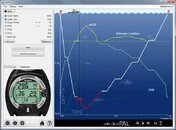Foxfish,
I think I was not clear on what I tried to say in my first post, and that I may have subsequently added some confusion to the debate you proposed. I will try now to tell you what I intended in a more thorough and, hopefully, understandable fashion.
The effects of oxygen toxicity on the central nervous system (CNS) depended on the partial pressure of oxygen breathed and duration of exposure. Divers track the degree to which their CNS gets compromised during a dive through tables (such as NOAA's) or computer algorithms, both of which give them a result in terms of percentage exposure in relation to the maximum recommended (which is usually referenced as %CNS).
The susceptibility to the effects of oxygen intoxication, however, is not uniform from diver to diver or for a same diver in different days. This fact has led to the adoption of a few practices. The first is to plan to limit the exposure to 80%. You can verify that the Suunto Cobra, which has been mentioned in this thread, gives an alarm sign when the exposure reaches 80%. The second practice adopted is to recommend divers to limit the partial pressure of O2 in their breathed gases during the working phase of a dive (any part of a dive for a rec diver) to 1.4atm.
The inconsistency in the effects of O2 exposure, though, has made it impossible to set a hard line on what is the maximum ppO2 breathable without incident. There is only the concept of risk of adverse outcome. Agencies, then, recommend a certain ceiling on ppO2, but a diver may decide there is another value of ppO2 that they think they shouldn't go beyond and plan their dive accordingly. Therefore, many divers choose to operate with a limit of 1.3 atm or 1.2 atm.
On the other hand, some divers have decided in the past (and I am NOT advising anyone to do it) that they can operate with a ppO2 higher than 1.4atm. The book "Shadow Divers" (great book, by the way) deals with the discovery of a wreck 240ft bellow sea level. The people who first dove it did so on air - the ppO2 was as high as 1.7atm.
In any event, when a diver plans their dive, they decide what is the maximum ppO2 that they will tolerate. This value, together with their selection of gas, will dictate the depth at which the ceiling ppO2 would be attained. This depth is called the maximum operating depth or MOD. After identifying their MOD for a dive, then, there is no reason to go beyond it meaningfully but for an emergency. Not because they will suddenly die, but because they will expose themselves to a risk they are not willing to take.
So, to answer your original question: no thinking diver ventures in an appreciable manner beyond their MOD except for an emergency. What the MOD for a given gas is, however, may vary from diver to diver, and the MOD is only one of the parameters used to control the risk of an oxygen toxicity CNS hit.
I'm sorry for the long post and for repeating some of what others said before in this thread.





